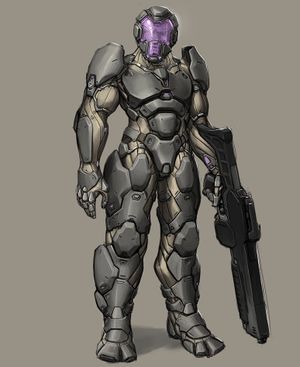
The Class 1M Combat Armor is a light weight successor to the Class 1K Advanced Cybernetic Exoskeleton. Made with a new plasticized tritanium mesh which protects the occupant from sensor scans as well as most forms of electromagnetic radiation.
Protection
The armor itself is capable of withstanding near-warp acceleration curves by using a revolutionary micro-IDF (Inertial Dampening Field) which minimizes the inertial forces on the armor and its occupant. The internal coolant layer is capable with withstanding temperatures in excess of 3000 degrees before the material begins to degrade for up to 15 minutes. The external layer is capable of withstanding a direct impact of 750 kN to the armor's main body without transferring that energy into the occupant.
It is also equipped with a personal deflector shield as well as an adaptive camouflage mode with holographically makes the armor near invisible through bending light around the contours. This effect is not perfect and a slight distortion is visible along the armors contours.
In addition the armor also has an adaptive filtration system as well as its own oxygen supply and carbon dioxide scrubbers. The occupant can survive even in a hard vacuum for up to 9 hours, even in direct unshielded sunlight.
HUD
The exterior has a full sensor array mounted around the helmet and this information along with any other needed information is fed into the armors heads up display.
Onboard Computer
An adaptive computer system is contained in an encapsulated computer core within the armor set in the helmet. This computer core is able to adapt the armor to the occupants current needs by altering the IDF and SIF (Structural Integrity Field) and managing heating and cooling of the armor as well as warning of damage and critical situations. It has a subspace and RF communications array built in.
Power Source
The armor uses twin micro-fusion reactors with a backup high energy plasma battery.
Motor Assistance
Using motor assistance the armor gives its occupant an effective lifting capacity of 5-6 times a normal humans lifting capacity along with a 8-10 times increase in running speeds. Due to the inertial dampening system the speed of movement as well as manual dexterity are given a 50% increase over human norms.